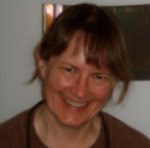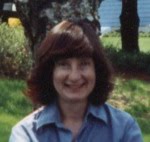The Log Cabin is sometimes taught using a sew and whack method but I find that it's harder to be accurate that way, and can be frustrating for both new and experienced quilters. It seems to work better for me if I cut the pieces ahead of time and, as I'm sewing them together, they keep me in line--and the block square.
For a 12" finished block, you will need:
(1) 3-/12" square (Traditionally this is red, to symbolize the hearth in the log cabin, but--whatever!)
(1) 2" x 3-1/2" rectangle dark
(2) 2" x 5" rectangles light
(2) 2" x 6-1/2" rectangles dark
(2) 2" x 8" rectangles light
(2) 2" x 9-12" rectangles dark
(2) 2" x 11" light rectangles
(1) 2" x 12-1/2" rectangle dark
You are going to sew each of the 2" strips, in a counter-clockwise direction, around the center square, with two adjacent sides dark, and the the other two adjacent sides light.
Start by sewing the 2" x 3-1/2" strip to the top of the center square. then, sew a 2" x 5" light rectangle on the left side the square, and a 2" x 5" rectangle at the bottom. For the end of the first round, sew a dark 2" x 6-1/2" rectangle on the right side.
Continue around, clockwise, adding increasingly rectangles and making sure that you keep lights on one side, and darks on the other.
You can change the size of the block by changing the size of the center (and adjusting the lengths of the rectangles accordingly), or by adding more rounds, or making the rectangles more narrow.
Now the fun begins because there are a great many ways you can set log cabin blocks, creating very different looks by simply rotating blocks. Here are a few possibilities:
And here are a couple of my quilts--none of them finished yet. Sigh.
This one has upper and lower borders of log cabin blocks. (Sorry about the pins--I'm still quilting it.)
This one combines Friendship Star and Log Cabin--a design of mine called "Stars Over the Cabin." (Yes, still quilting this one, too.)
b
There is another variation of the Log Cabin called Courthouse Steps. In this variation, you still do dark and light, but darks are on opposite, rather than adjacent, sides. (And the same for lights, then, too.)
So, play with Log Cabin, have fun with it--and share the results with us!
























